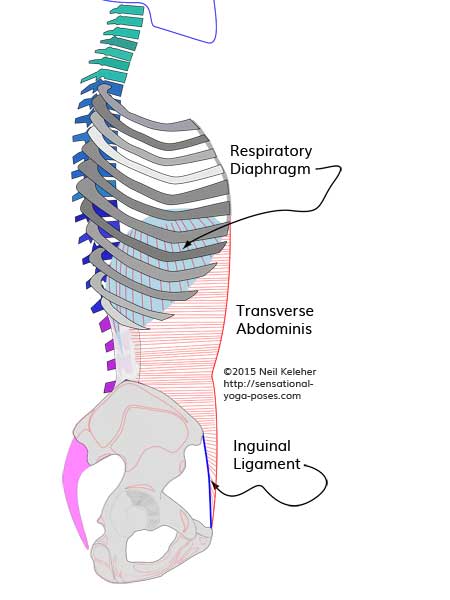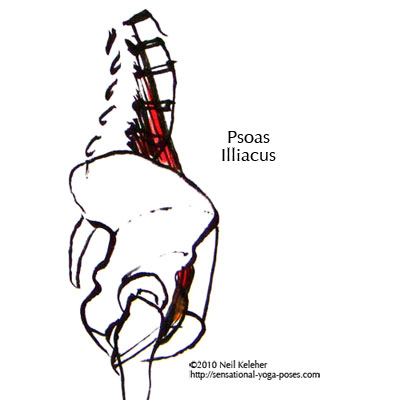Learning to feel your diaphragm and psoas
(while going to the bathroom)
So that you can learn to feel your diaphragm and for that matter your abdominals and your psoas, notice what happens next time you go to the bathroom for a number two. Notice your abs tensing and a downwards pressing feeling.
Each time you push, does your lower back feel like it is experiencing a forwards pull?
Respiratory Diaphragm and Transverse Abdominus.
Apparently we are designed to poo while squatting. The goal of this article isn't to get you to adopt the squat technique for going to the bathroom, but this can be useful information when trying to understand the mechanics of pooing, and also so that we no where to put our attention when trying to learn to feel the our own respiratory diaphragm and perhaps even the psoas.
In a squat the front of the hips are closed, so that the knees are close to the chest. We can simulate this while on the bowl by pulling our feet back as far as possible, and then slightly pressing down into our feet while leaning forwards so that our buttocks just lightly touching the seat.
(This will obviously be problematic if you have short legs.)
Feeling the Psoas
One muscle of main importance in this position, and especially doing a poo, is the psoas.
Within the belly cavity, its fibers reach forwards and down from the front of the lumbar spine to the front of the pelvis.
Some of its fibers may partially support the rectum. If not directly then via connective tissue which acts or looks like a downwards sloping hammock for the rectum.
When contracted, the psoas may help to till the rectum forwards helping to put it in the ideal position for offloading our payload.
Because the psoas can be used to pull the lumbar spine forwards, it can cause the pelvis to tilt forwards and in the process increase the natural backward bending curvature of the lumbar spine. We can counter this tendency, or the body naturally counters this tendency, by engaging the abs.
Each time you push, do your abs engage? Does your lower back feel like it is being pulled forwards? If you can feel your lower back being pulled forwards as if from inside your body, that just may be your psoas activating.
The Respiratory Diaphragm (The One we Breathe With)
While the psoas may help to tilt the rectum forwards, the diaphragm may help to provide the necessary pressure to evacuate our bowels. When activated, this muscle, anchored along the bottom rim of the ribcage as well as to the upper few vertebrae of the lumbar spine, can create a downwards push on the abdominal organs.
Note that pushing down isn't enough. The pushing force has to be directed, the way the barrel of a rifle helps to direct the expanding gases that then push the bullet down the barrel. This "directing" of forces happens via the abs.
Next time you are squatting, or sitting, see if you can feel a downwards push and better yet notice where it is coming from.
The Abdominals and Diaphragm work as a Pump
Now one of the cool things about all of this is that most of the same components are used when we breath, or can be used with breathing. Basically our abs and diaphragm can be used as pumps. In the case of air they can be used to create a vacuum to draw air in, and then used to push air out. In the case of a number two they are solely used as a push pump to push stuff out.
When breathing we can use our diaphragm, pushing it down to increase the volume of our lungs to draw air in. This action pushes down on the abdominal organs which, assuming the abs are relaxed enough, causes the belly to push outwards.
Then we can use the abs to push these organs in and the diaphragm up to reduce lung volume and push air out.
Together we can simultaneously use the abs and diaphragm to squeeze the abdominal organs, which means we squeeze our intestines, and rectum and guess what comes out!
If we more finally tune our ab control, we can pull just our lower belly in so that our upper belly expands. If our abs are relaxed just enough then when our diaphragm contracts it can push the ribcage upwards. If in addition we expand the ribs we've got extra power for drawing more air in.
I Practice My Kegel Exercises Every Day!!!
(I'm even practicing them now)
So what was the point of talking about taking a poo? A while back some guy name Dr Arnold Kegel became famous because he taught women how to orgasm by doing simple exercises that helped them tune in to their pelvic floor so that they could contract, relax and orgasm at will. He taught them how to learn both sensitivity and control. One description that is commonly used-"Use the same muscle that you use to control the flow of pee."
In a similar way, we can use "number two" time to feel our diaphragm, abs and psoas or to practice feeling them, or at least to practice putting our awareness in the right place so that we can get used to feeling them.
This sensitivity can be used to improve body control both on and off the pot. As an example, on the pot if you are having trouble squeezing stuff out, you might focus on a downwards sensation in the lower belly. Focus on the feeling rather than thinking about the feeling. You may notice actually movement as a result.
An analogy could be that the bomb bay doors are stuck so the copilot has to go back and unwind them manually. Likewise, if your bomb bay is jammed up, put your awareness down there to help get things flowing. (Bombs away. Roger that, returning to base.) (Credits roll with a picture of an airmen coming out of the commode, toilet paper trailing out his pants.)
Noticing the sensations of our diaphragm, psoas and abs engaging while on the pot, off the pot we can continue to feel and control these muscles while breathing, doing yoga or tai ji or while having sex... or while doing anything else that involves the body.
The Connection to Swimming...
The original version of this article was inspired by a swim. After swimming a few laps I felt the strong urge to go to the bathroom.
I put it down to the action of my legs and hips helping to loosen my bowels. Perhaps the kicking was causing my psoas to activate which kept pushing on (or massaging) my bowels, hence the sudden urge to leave the pool.
Published: 2020 08 27




